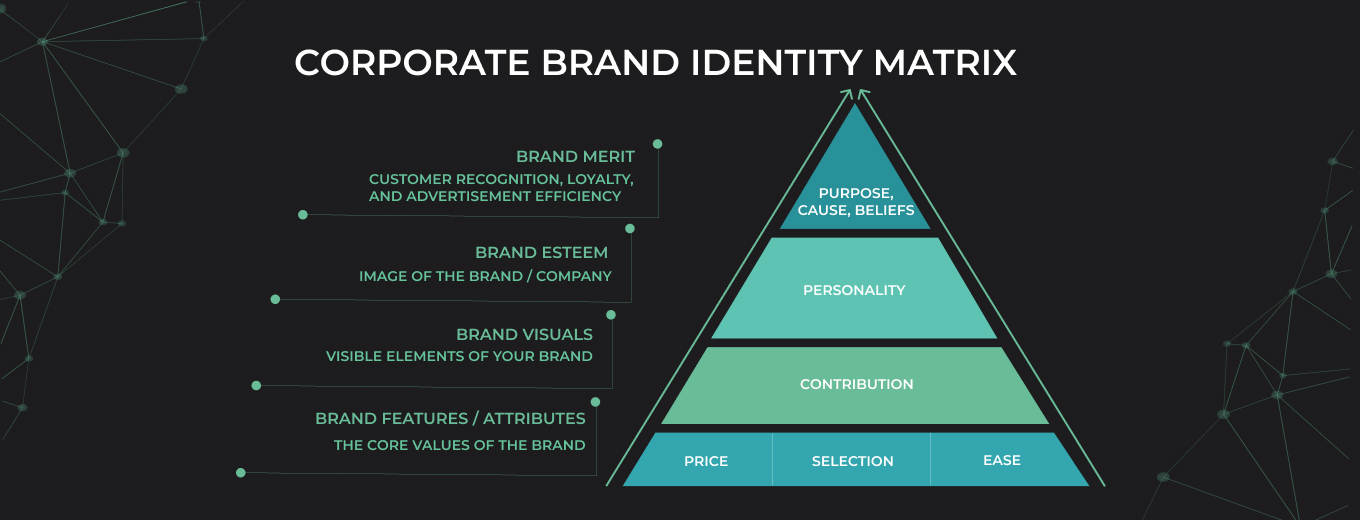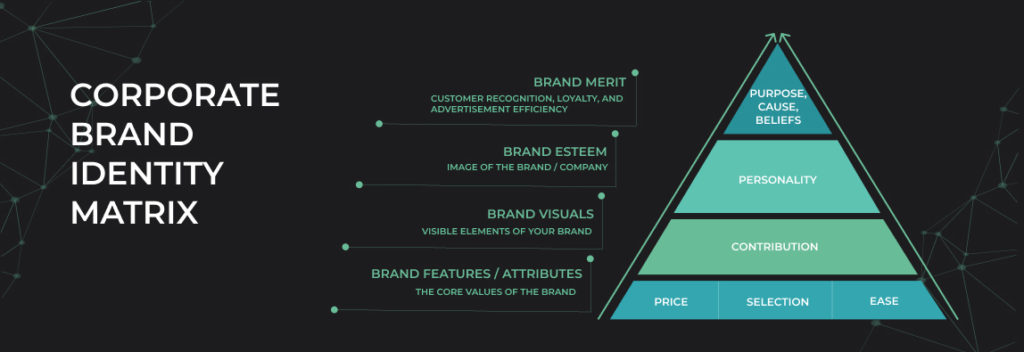
Svitlana Rakova
СОО



Companies usually have no problem branding their products. But when it comes to corporate branding, they have trouble identifying themselves. Organizations have to work hard to create the right message for their company. It is essentially important how clients, staff, and stockholders perceive them. A clear and logical corporate brand identity makes hiring employees easier, improving your image and increasing your company’s visibility. One of the most successful practices for this case is using the Corporate Brand Identity Matrix (CBIM). Learn exactly how it can help and how to use it.
Many people often confuse the concept of image and corporate identity. Your customers and external partners create your image. What is corporate identity, then? It is how the company itself would like to be perceived by others. They say, “as you name the boat, so shall it float,” and there is no better description of corporate identity because how you are perceived depends only on how you present it. So why do you need it?
Corporate identity is part of a company’s competitive & marketing strategy. Customers don’t like surprises and don’t trust unknown companies, but if you can create brand awareness, you will stand out from your competitors.
With the advancement of corporate branding, you can also enhance the recognition of your mission, which will facilitate the spread of your message of values and services to the masses. It will help shape the corporate culture and set the tone of your business.
One of the frequent problems for organizations is the “loss” of a maternal company’s self-identity through the creation and superiority of subsidiaries. Also, companies have difficulty when they add something new to their existing services. Lastly, some companies use organization branding to improve their initially poor corporate image.
The brand matrix results from 10 years of work and research by various business sectors. Nowadays, thousands of companies worldwide use this tool to improve their market position and create a stronger sense of identity.
The principle of the matrix lies in working through several layers of the firm through questions and answers. Each question is associated with an element of the company’s identity. In total, nine brand elements can be identified. The following layers of the matrix are distinguished in turn:
Below, we will describe the layers of the matrix in more detail.
The internal elements are the foundation of the company. They portray the fundamental organizational values, mission, and culture. This is what inspires employees and improves their self-identity. They begin to understand how to behave to fit the company’s brand. Some companies choose words to describe a brand which best represents the inner state of the company and reminds employees of their values.
External elements define how the company wishes to be perceived by clients or shareholders. They are responsible for external positions, offerings, and connections. For example, Adidas wants to motivate its customers to achieve new wins, and its slogan is “Impossible is Nothing”. Of course, it offers its sports products as a reliable shoulder on the way to new heights.
These elements relate to communication features and the core of the brand. The latter represents the essence of the company’s identity- its unshakable values – what it promises and unquestioningly delivers. Every company’s action will reflect the brand’s core if the corporate identity is built correctly.

You can start improving your brand identity by compiling a brand matrix. It will give you a deeper insight into your weaknesses and how to fix them. An entire executive team should approach the creation of the matrix. To do this, they need to answer the branding questions of all nine elements. Let’s highlight these very questions:
-What are your core offerings? And how might customers and other stakeholders like them?
-Determine how you will interact with clients and other stakeholders
-What position do you want to convey to the minds and hearts of your customers?
-What is your personality? How does it show up so you can be recognized from afar?
-What do you promise your customers? What exactly are the values that make up the holistic picture of your brand?
-What is your corporate character? What are the human qualities that describe it?
-What is your mission? Why do you do what you do? What serves as your inspiration?
-Your behavior? How do you work and show your attitude?
-What is the specialty that sets you apart from the competition? What are your particular strengths?
Experts say it’s best to be succinct in your answers — answer without thinking. If you see inconsistencies between your answers, this will indicate a problem and point out where the problem lies. Another tip is to look far into the future. Your brand should remain relevant for years, since developing a new one takes a lot of time and effort.
As mentioned earlier, all the answers must intersect harmoniously in the brand’s core. You have to coordinate all the vertical, diagonal, and horizontal axes. Each one is responsible for a different company’s capability. The more logically aligned these axes are, the stronger the matrix will be. The company culture may not match their external relationships, or your competencies may not fit your promises. The best way to check the balance of these concepts is to create a small presentation. Then, the executive team has to come up with solutions to all these inconsistencies.
Companies around the world can face a variety of identity issues. Below, we highlight the most common brand identity issues and how a brand matrix can help you.
It is often the case that the parent company creates several subsidiaries that end up overshadowing it. A brand matrix pulls everything together and shows customers what exactly is behind the brand. It helps shape the identity of the subsidiaries and assemble a complete picture of a unified corporate design.
Let’s imagine that your company has been selling kitchen units, but then it decided it would also sell bedroom, living room, and bath furniture. In that case, the company’s corporate brand will be subject to change. You will have a difference in your mission and competencies, and your customers must be ready for that. Furthermore, you should verify that your staff is fully aware of their current corporate identity. In that case, a good practice would be to organize meetings and further parse the brand matrix, which has also changed. It’s great for establishing new realities and smoothly introducing new products into your portfolio.
Sometimes, because of unfortunate slogans or events, companies have an unpleasant image. Developing a brand matrix can help companies look friendlier to their customers and other stakeholders. With it, companies can improve their brand identity and message.
Brand identity must constantly be worked on for a company to remain competitive, recognizable, and successful. Sometimes, companies can get forgotten or take a wrong turn, harming their self-identity and brand. Creating a brand matrix can help you better understand your culture and message and build a strong brand improvement strategy.
Comments